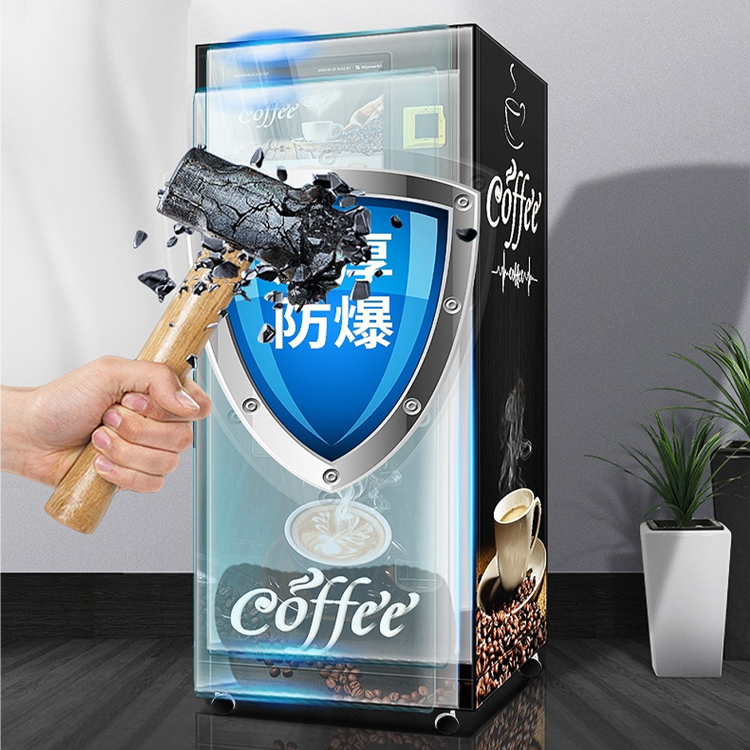| Aspect | English Description |
|---|---|
| Name | Coffee Vending Machine |
| Basic Definition | An intelligent device that accepts payments via coins, mobile payment, etc., and automatically performs coffee grinding, brewing, and cup dispensing. |
| Basic Working Principle | Typically involves user selection, payment, automatic coffee bean grinding, brewing (controlling water temperature and pressure), adding ingredients (sugar/milk), and cup dispensing. |
| Main Types | By Brewing: Powder-based, Freshly ground bean. By Size: Tabletop, Cabinet-style. By Payment: Coin-operated, Mobile payment, Multi-payment integrated. |
| Core Advantages | Offer 24/7 service, are convenient and efficient; save labor and rental costs; provide diverse coffee options and personalization (e.g., strength, sweetness); quality is improving with technology. |
Working Principle & Process
The workflow of a coffee vending machine combines automation technology, precise control, and IoT applications, with the core goal of ensuring consistent coffee quality and serving efficiency.
-
Selection & Payment: The user selects the coffee type (Americano, Latte, etc.), strength, sugar level, or milk amount via a touchscreen. Payment methods are diverse, including mobile payment (scanning a QR code), coin operation, card swiping, etc.
-
Grinding & Extraction (for fresh-grind models): The machine takes a measured amount of beans from its built-in coffee bean storage and grinds them using an integrated grinder. The grounds are then tamped into a brewing unit. Pressurized hot water is used for extraction, with the brewing unit precisely controlling water temperature, pressure, and time to achieve the optimal flavor.
-
Mixing & Blending: Some models are equipped with multiple auxiliary material boxes for storing milk powder, syrup, chocolate powder, etc. Based on the user’s choice, the machine automatically mixes the extracted coffee with these ingredients.
-
Cup Dispensing & Filling: The machine automatically takes a paper or plastic cup from the cup storage and places it under the dispenser outlet, where the prepared coffee is poured in.
-
Pick-up: Once preparation is complete, the machine prompts the user to take the coffee from the pick-up port. Some high-end models may also provide functions like attaching a lid or dispensing a stirrer.

Main Types
Coffee vending machines can be categorized based on different criteria:
-
By Brewing Method:
-
Freshly Ground Bean Type: Uses whole coffee beans, grinding them fresh for each cup. Offers superior flavor and represents the current mainstream and high-end standard.
-
Powder-based Type: Uses pre-prepared instant coffee powder or other beverage powders. The mechanism is relatively simpler and more cost-effective.
-
-
By Size & Form:
-
Cabinet-style: The most common type, similar in size to a refrigerator. Offers large capacity and strong potential for expanded functionality.
-
Tabletop: Compact and lightweight, suitable for offices or spaces with limited room.
-
-
By Payment Method:
-
Traditional Coin-operated
-
Smart Payment Type: Supports QR code payments, card payments, and even facial recognition.
-
Advantages & Features
The popularity of coffee vending machines is due to their multiple advantages:
-
Convenience & Efficiency: Provides 24/7 self-service with no need to wait in line. The entire process takes about a minute, making it ideal for fast-paced lifestyles.
-
Cost Efficiency: Requires no staff attendance, significantly reducing labor costs. Their small footprint and low site requirements help save on rental costs.
-
Diversity & Personalization: Offers a wide range of coffee options (e.g., Americano, Latte, Cappuccino). Users can often customize sugar level, strength, and milk quantity.
-
Quality Assurance: Fresh-grind models ensure consistent output by precisely controlling grind size, water temperature, pressure, and extraction time, often incorporating good bean storage technology (like cooling preservation).
-
Environmental Considerations: Many models now use biodegradable paper cups or encourage users to bring their own cups to reduce environmental impact.
Future Development Trends
Coffee vending machines are evolving towards greater intelligence and user-friendliness:
-
Intelligent Upgrades: Use of IoT Technology for remote monitoring, fault alerts, and inventory management. AI analyzes user preferences for smart recommendations.
-
Product Diversification: Beyond coffee, many machines can also provide other hot or cold drinks like hot chocolate, tea, juice, and even more diverse products like smoothies.
-
Environmental Protection & Energy Saving: Increased use of energy-saving components and eco-friendly materials, optimizing energy efficiency.
-
Crossover Integration & Value-added Services: Potential collaboration with e-commerce platforms or media to display ads, promotions, or other value-added services on the interactive screen.





